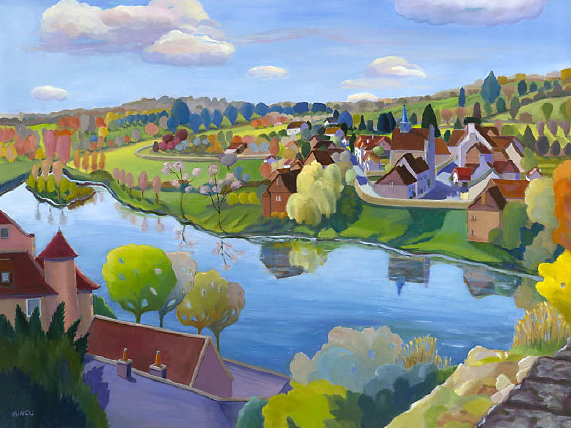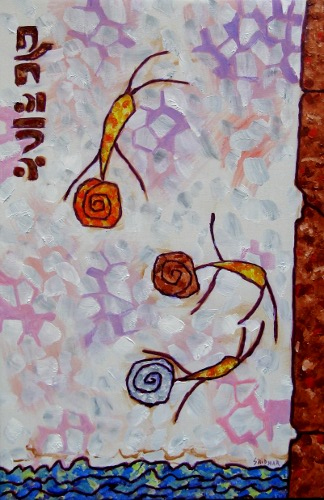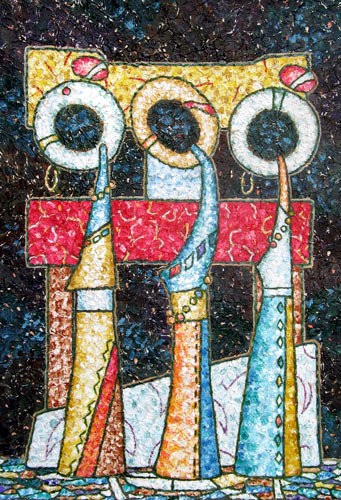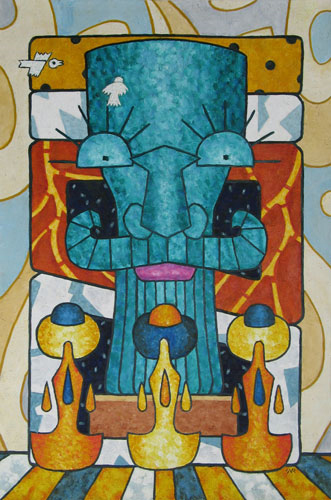Archived Comments
Enjoy the past comments below for Never satisfied…
Dissatisfaction with your art doesn’t mean that you have to suffer. It can be seen as a quest or adventure. It can actually be inspiring: always more to learn, always finding a way to kick things up a notch.
Death and Destruction are never satisfied, and neither are the eyes of man. I always find comfort in a little proverb here and there. Something’s missing? My suggestion is to pull your head out of the sand box. Possibly stop trying to direct the show and you may become open to the clarity and vision you seem to be asking for. I am reminded of Edvard Munch who later in his life wrote, “I inherited two of mankind’s most frightful enemiesthe heritage of consumption and insanity.” What ever youve got going on inside, make it work for you.
I have been taken round the world and back again. I am no body in a some body. I have displayed my feathers and closed down my lot. To feel pain and sorrow and work through it is at times like a mad man entering the eclipse of the sun; I am lost beyond shadow and doubt.
a painting may be perfect while the person painting is not. consider imperfect can be wanting more of your work or wanting to add but unable to improve. many times the sense of incomplete when it arises is in fact where you need to leave your work and assume its done. a suggestion; try to do one thing perfect, start with one line or with one brush stroke. last, imperfect is the absolute of human endeavor. namaste
A painting does not need to be perfect; in fact most are not. We don’t even know what perfection in painting is other than an opinion.
I’ve been reading your letters for quite a while and I have my own question: What is a fine artist? The reason that I ask was due to an interaction this week. I’ve only been painting for about 4 years and oils in the last two years, so I’m pretty new to this. I took some classes at a local university and have been studying (once a week) for the last year with an artist who studied with Frank Mason. My instructor, Karen Winslow (Cambridge, VT) is teaching me quite a bit. I’m definitely improving. So, I’ve run into situations where I talk to other artists and they say that they are “fine” artists. I mention that I’m an oil painter and they start talking about getting gallery representation. I mention that I sell a lot of my work out of my office or at craft shows. Some comment generally comes up to the equivalent of “Oh, you’re JUST a craft show artist… I’m a fine artist”. Then comes the comment that your paintings are “nice decorations”. So, what is a fine artist? Do I have to have gallery representation and go to some prestigious art school to be considered a fine artist? Personally, I like my work and I like the fact that I can sell my paintings and prints. I know that I have a long way to go and a lot to learn. However, would it be reasonable to market myself as an oil painter or a fine artist? http://www.doughoppesstudio.com
Renoir on his deathbed was reported to have said, “I think I’m finally beginning to get it.” Or something to that effect.
How do you know when a painting is done? The painting tells you. Keep painting until it is done to your standard. Quality control is what an artist establishes for his on work, Determining that standard and maintaining it consistently is what is the basis for own image as an artist.
Very interesting groups, I imagine that these may also be stages in an artists career as well. Meaning that as we grow we pass through some of these characteristics. I believe I’m more in the final group of looking for praise as I point out my own works failures. Really though, I think that most of the time, we artists put way too much drama into how we feel about our own work. Is that the right color?, Is that composition correct?, Am I painting in the right light?, Is that the subject that people will like?, What are people going to think of this?, Is it up to my standard, because I am great!, etc…… I’ve found that the least I like my own work, the better it sells LOL. Is it that I can’t tell what is good or bad or even if my own taste in art sucks LOL. I let the painting take it’s own path and I’ll through it out there and see what happens. I may like it, I may hate it, it may sell right away, it may not, it is what it is, it’s a Greek. And that is all it will ever be.
I climb the stairs to my studio every day never knowing how I will see things. Sometimes I am satisfied with yesterdays work and sometimes not. It takes a lot of focus though to decide what works and what doesn’t. It also takes time and space for me. I have to separate myself from the painting or act as if someone else painted it. Then I can be fair in my criticism. The universe has a dual nature. For every problem, there is a solution within the problem. If I recognize a problem, there is my gift to myself. I go there. That is my gift to the world as well. Doing my best is sometimes just showing up, rain or shine, and trudging through the muck.
I just spent quite awhile puzzling over which category describes my state of chronic dissatisfaction with my work. I think it depends on the genre for me. I can’t say I am ever completely satisfied and when the piece is still in my possession and in sight I am always at risk of going back in. Sometimes you just have to move on to the next thing rather than getting mired in the past.
There are days when I wish I could create art which is more abstract with a punch full of color and dynamics! My mind and hands seem to be locked in the same old manner of doing things and can’t break the chains or is it more the psychological fear to trying and not being able to succeed? The only place where I see a glimmer of something different is in printmaking where the unexpected can rise to the surface.
I have what I like to call “my art sucks” days. I had another friend in response to that by saying just as long as it isn’t a huge pile of c**p you should be okay.
I studied privately with a teacher in Venice Calif for 15 yrs. At the end of every painting I would say to him “once again I’m three strokes short of a Vermeer!” He would assure me that Vermeer said something similar at the end of each one of his paintings!
There are times as artists we feel that way. Who does not like to have great work that perhaps may persuade the viewer to acquire because of the beauty he or she sees in it? I think that it is alright to self critique ones work to improve it and to learn when to stop. But if we are never satisfied with what we have done in the end we are creating a self fulfilling prophesy that will lead to more dissatisfaction. I create because I have an inspiration and I admire beauty. I can be proud to posses the talent to express my inspiration and to interpret my perception of the world around me. I also hope that other people can share the vision I see that is expressed in my art. As I can see Mr. Sridhar’s painting are unique and quite detailed.
All you need to do is mentally mix the color and say go. Presto it’s done. I am, like always, dreaming of color. Talking about color kindly inform me what is your understanding of this word “dissonance” in color, and I must warn you, I need more than violet is complementary to yellow, hence in dissonance to blue. What yellow (cool warm) which violet so fourth and so on. Let’s get some impressive color theory going in here. Maybe the blue is not a good choice. Goethe considers yellow and blue complementary. I am open to further discussion. Thanks a million and a pleasure to write to a brother in arms (paint) Robert. Nader from Gilroy! the Garlic capital of the world in Northern California
I love the texture and color of these paintings. I believe dissatisfaction is a sign to push on, stretch, grow. I always seem to have that little devil sitting on my shoulder saying “not good enough”. While I acknowledge that is certainly a possibility, I can tell it to “shut up for a minute” and let me enjoy this effort, until I move on to the next. I might add that these painting are the first to move me to write a comment; I’ve had such a positive response to them!
Is a painting ever REALLY done? Or is it a matter of knowing when to stop the current “lesson” and move on to the next? Maybe being unsatisfied is a merely a stepping-stone to improvement in your work. I think total satisfaction in one’s work might lead to stagnation and boredom.
I have viewed too many artists since I signed in on FB, and though it hasn’t affected my business aspirations it surely has challenged my respect for my own work (occasionally). Something derogatory I read about artists and their usual financial status really flavored this mood, as well as my current state of not being able to display what I would consider my best work…There is so much to be said about pre-designed computer apps for artistic work, two of them are functional but encompassing and/or restrictive. Anyway I’m accepting my current boundaries and hoping to unleash the hounds sometime in the near future, that phrase is a little over the top, but you may consider it a self-help thing. As usual you are in touch with the woes of the artist!
It’s so much better to work in a vacuum without posturing, professional or otherwise, realizing the kind of joyous struggle you mention, and to keep one’s own counsel. Yes, self criticism and doubt are part of the growth equation.
“…I never seem to be satisfied with what I produce.” And this is a bad thing?? Imagine, tomorrow, you create your masterpiece..What’s left? Keep working and be happy you can get up again and again and find new things to work on. Be satisfied you did your best today.
David Leffel suggests to make sure you have a clear idea of what you want to achieve before you start. Then it’s not hard to know when you are finished. You subsequently have an opportunity to be satisfied. Thierry got it right: there is no perfection in painting.
I’m satisfied if I drag myself home after a day in the field, regardless of the quality of the work. On the whole, I’d prefer decent work, but satisfaction is having another day to be able to go at it hammer and tongs. Perhaps this is an elder person’s perspective and seems strange on a person with fewer years. Then again, perhaps it’s the result of my meditation practice, or having had threatening health issues. I’m glad I only have to wrestle with the problems while I’m at the canvas, not before, and not after.
I see I can’t spell either LOL ….through=throw
For me satisfaction in painting comes in that last brush stroke when I intuitively know it’s done. I look at it for a while and revel in it. Then I can’t wait to show it to friends and family. But then a month (or a year) later I look at the work with fresh eyes and wonder what the heck I was thinking. I may even rework it. I think it was Picasso who said ‘A painting is never done – they just stop at interesting places’, or something to that affect. Sure painting’s frustrating. But it can be very rewarding, too, right? … that’s why we keep painting. Artistic expression is a process. We will do some duds – for sure. I think that if you’re not doing some “bad” work occasionally you’re not stretching, not experimenting, not learning. Bottom line – what if every piece you painted turned out exactly like you had envisioned it – perfect. How boring would that be?
I wonder at artists who create but are unhappy in their work. I should think the act of creating artwork is, or ought to be rewarding in its own right, regardless of its qualities. Commercial success tells us something about those qualities and how we’re doing with them, but it isn’t the only criteria by a long stretch as to whether we should do it or not. It either brings us joy or it doesn’t. Maybe like Algebra. And as for those qualities, if there is movement and improvement in what you are doing, more the reason for joy. My heart goes out to those who are ‘never satisfied’.


French River Town oil painting by Bonnie Mincu, New York, NY, USA |























I still love this painting Rick. Such mood…..I remember standing at the gallery and seeing that scene every time I was there.